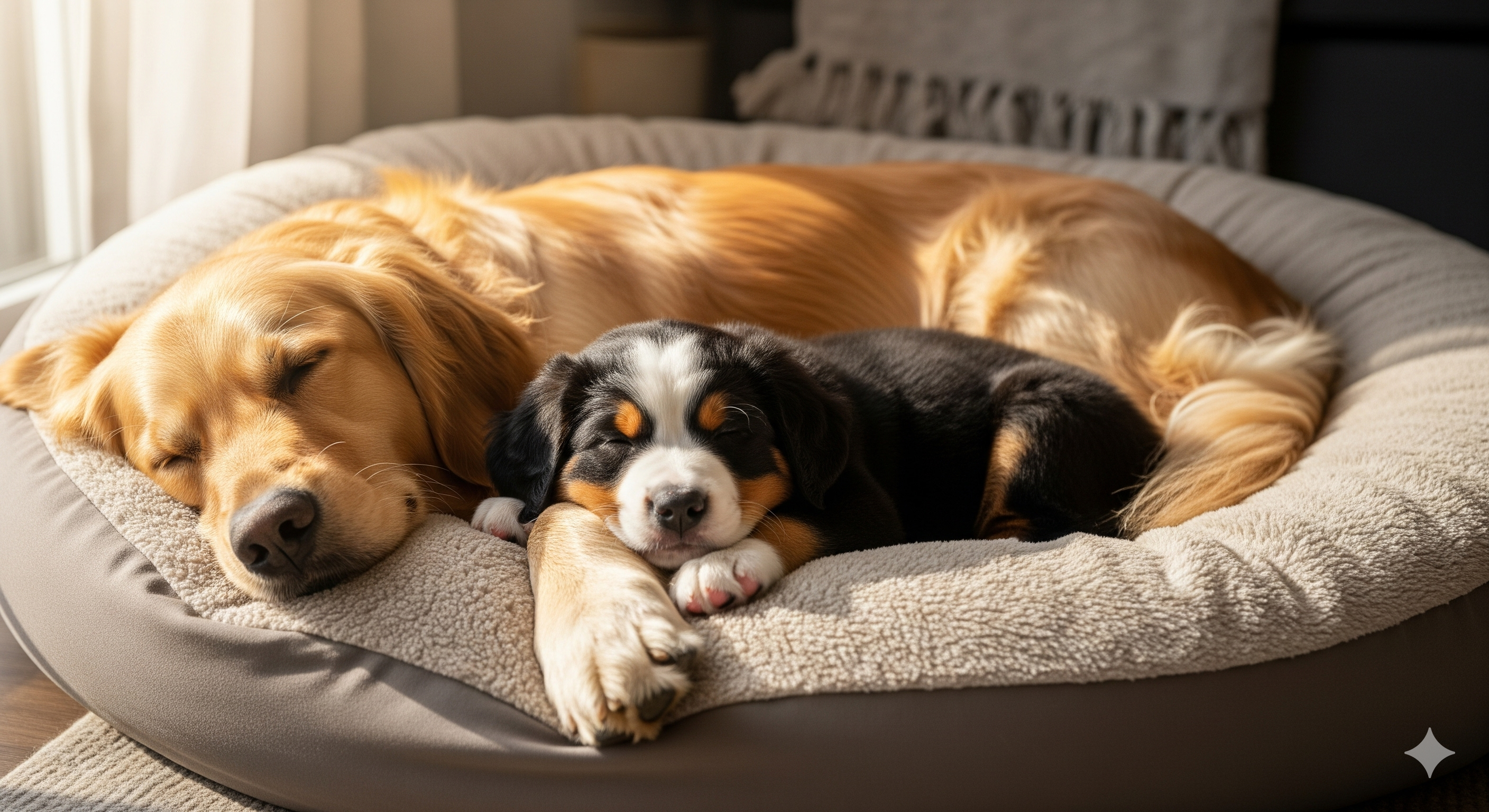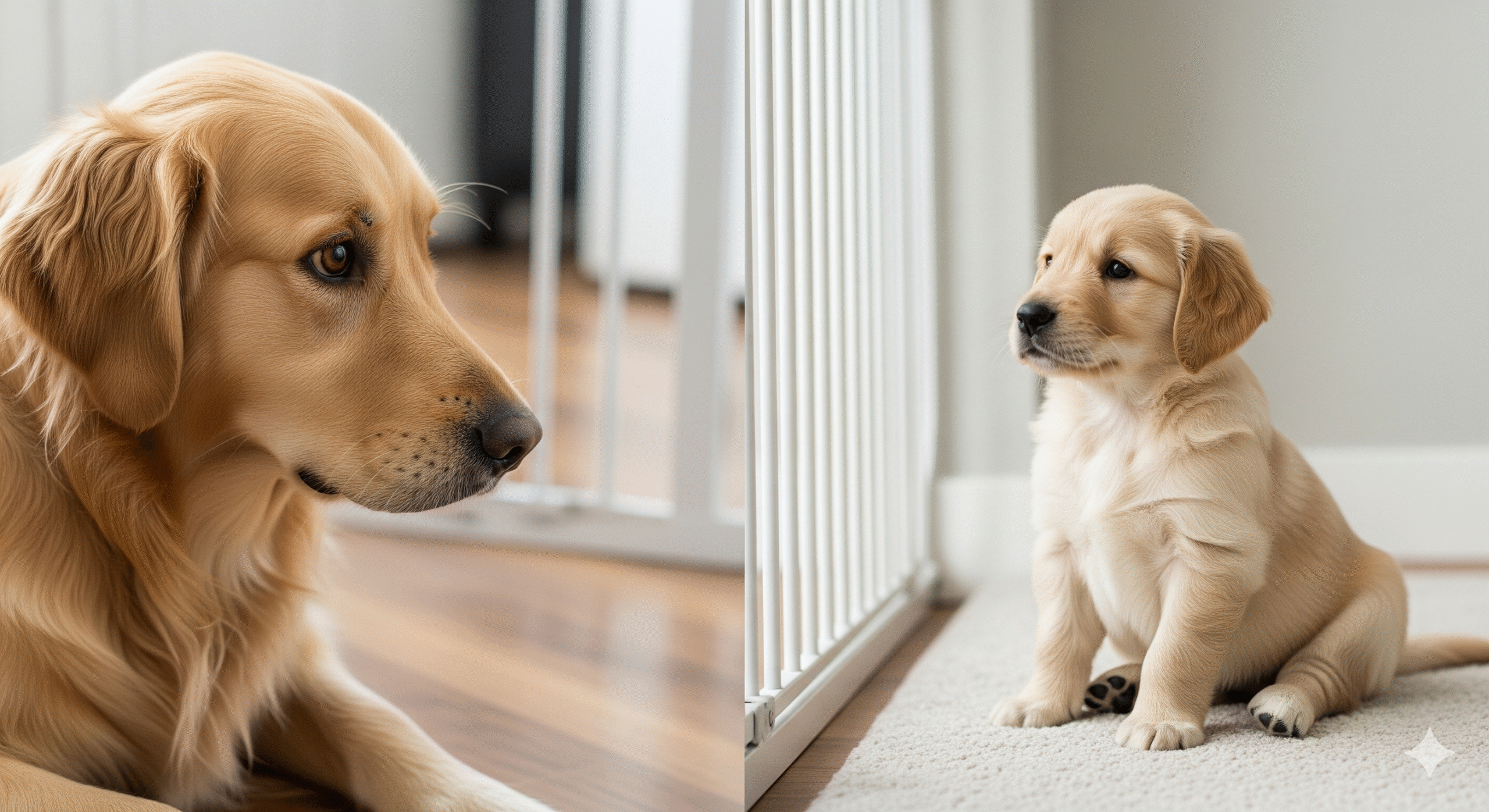Bringing a new puppy home is a whirlwind of excitement, cuddles, and adorable chaos. But while you’re focused on this fluffy new addition, have you checked in on your resident dog or cat? That sidelined glance, the low growl when you pet the puppy, or the sudden “accidents” on the rug are not coincidences. They are clear signs of pet jealousy new puppy dynamics at play. 😥
This jealousy is a normal, instinctual response. Your established pet is thinking: “Who is this little intruder, and why are they stealing my human’s attention?” Left unaddressed, this jealousy can escalate into stress, anxiety, and even aggression.
But don’t worry! This comprehensive guide provides a deep dive into understanding the root of this jealousy and offers a step-by-step plan to manage it, ensuring a harmonious, multi-pet household where everyone feels loved and secure.
Why Jealousy Happens: It’s Not Spite, It’s Science 🧠
First, it’s crucial to reframe how we see this behavior. Pets don’t experience jealousy out of spite; rather, they feel a threat to their valuable resources and social standing. Your home is your pet’s entire world, and you are its most valuable resource. A new puppy represents a direct threat to that security.
Key triggers for pet jealousy include:
- Resource Guarding: Fear of losing access to you (attention, lap space), food, toys, or favorite sleeping spots.
- Disrupted Routine: Your established pet thrives on predictability. A puppy turns their calm world upside down with new sounds, smells, and changed schedules.
- Scent Invasion: A puppy brings a completely new and unfamiliar smell into the home, which can be inherently stressful for your resident pet.
- Redirected Frustration: Your older pet can’t take their frustration out on you, so they may target the new, obvious source of the problem: the puppy.
Pre-Arrival Prep: Setting the Stage for Success 🎭
The work to prevent intense jealousy begins before the puppy even crosses your threshold.
- The Vet Check: Ensure your resident pet is healthy. Pain or discomfort from an untreated condition (like arthritis) can make them much less tolerant of a pesky puppy.
- Scent Introduction: Before the puppy comes home, bring a blanket or toy with the puppy’s scent on it and let your resident pet investigate it. This allows them to process the new smell in a neutral, non-threatening way.
- Rehearse Your Routine: If you know your walking/feeding schedule will change, start implementing those changes a week or two in advance. This helps your current pet adjust without linking the disruption directly to the puppy.
- Define Safe Spaces: Create exclusive zones for your resident pet—a room with a baby gate or a high perch for a cat—where they can retreat and enjoy peace without the puppy bothering them. This is non-negotiable.
The First Introduction: Controlled and Positive 🤝
The first meeting sets the tone. Never just open the carrier and let them figure it out. Follow these steps for a calm introduction:
- Neutral Territory: If possible, have the first meeting on neutral ground, like a quiet park. If that’s not feasible, use a room in your house that your resident pet doesn’t consider their “territory,” like a living room.
- Leashed and Controlled: Keep both dogs on leashes, held loosely by calm adults. Allow them to see each other from a distance.
- Parallel Activities: Walk them parallel to each other at a distance, gradually decreasing the space between them if both are relaxed. Avoid face-to-face introductions, which can feel confrontational.
- Watch Body Language: Look for loose, wiggly body postures, play bows, and relaxed ears. Be on high alert for stiff bodies, fixed stares, raised hackles, growling, or lip curling.
- Keep it Short & Sweet: End the introduction after 5-10 minutes on a positive note, before either animal shows signs of stress.
The Integration Phase: Managing Life Together Day-by-Day 📅
This is where the real work happens. Consistency and patience are your best tools.
The Golden Rule: Attention First for the Older Pet 👑
This is the most effective strategy for combating pet jealousy new puppy issues. Always greet and pet your resident pet first when you enter a room. Feed them first. Give them treats first. This reinforces their seniority and assures them they are still top dog in your heart, effectively reducing their anxiety and need to compete for resources.
Resource Management: Eliminate Competition 🍖
- Feed Separately: Never feed the puppy and older pet side-by-side. Feed them in separate rooms or crates to prevent food guarding and stress.
- Toy Management: Put away your resident dog’s high-value toys when the puppy is loose. Only bring them out for supervised play or when the puppy is confined. This prevents possessive guarding and keeps prized possessions safe from destructive puppy teeth.
- Supervised Together-Time: Never leave the puppy and older pet together unsupervised. Use baby gates, crates, and separate rooms to manage their interactions until you are 100% confident in their relationship, which can take months.
One-on-One Time: Reassure Your Resident Pet 💖
Your established pet needs reminders that they are still special. Schedule dedicated, daily one-on-one time with them—a walk, a training session, or cuddle time—without the puppy present. This undivided attention is incredibly powerful in making them feel secure.
Positive Associations: Link the Puppy to Good Things 🎉
Create scenarios where good things happen for your resident pet only when the puppy is around.
- When the puppy is in the room, give your older pet high-value treats they only get at that time.
- Practice simple commands with your older dog (sit, down) in the puppy’s presence and reward generously.
- This conditions them to think, “The puppy’s presence predicts chicken! The puppy is great!”
Species-Specific Tips: Cats & Other Pets 🐱
The principles are the same, but the execution differs for cats.
- Vertical Space is Key: Provide plenty of cat trees, shelves, and high perches where your cat can observe the puppy from a safe distance.
- Guaranteed Escape Routes: Ensure your cat always has a clear path to get away from the puppy without being chased or cornered.
- Scent Swapping: Rub a towel on the puppy and then on the cat’s furniture (and vice-versa) to comingle scents before they meet.
- Never Force Interaction: Let the cat set the pace. They may choose to simply avoid the puppy for weeks, and that’s a perfectly acceptable outcome.
What NOT to Do: Common Mistakes to Avoid 🚫
- Do Not Punish Growling: A growl is a warning. Punishing it suppresses the warning, not the feeling, which can lead to a bite with no warning. See the growl as communication and create more space.
- Do Not Force Affection: Never force the animals to interact, snuggle, or play. Let their relationship develop naturally at their own pace.
- Do Not Neglect the Older Pet: It’s easy to get consumed by puppy care. Setting reminders for one-on-one time can help you avoid this critical mistake.
When to Seek Professional Help 🆘
While some tension is normal, certain behaviors require immediate intervention from a certified professional dog trainer or veterinary behaviorist.
- Overt aggression: Lunging, snapping, or biting that makes contact.
- Intense resource guarding that doesn’t improve with management.
- Signs of severe stress in your resident pet: hiding, refusing to eat, excessive vocalization, or soiling the house long after the puppy’s arrival.
Final Thoughts: Patience Paves the Way to Peace 🕊️
Managing pet jealousy new puppy tensions is a marathon, not a sprint. It requires immense patience, careful management, and a commitment to making every pet in your home feel safe and loved. There will be good days and frustrating days. Celebrate the small victories: a peaceful moment in the same room, a successful parallel walk, or a calm exchange of scents.
By following this guide, you are not just preventing problems; you are laying the foundation for a deep, rewarding bond between your pets. You’re giving them the greatest gift: a beloved sibling and playmate for life.
Ready to Build a Peaceful Pack?
Every pet dynamic is unique. Share your specific challenge or success story in the comments below—let’s support each other in creating happy, multi-pet homes! For more in-depth training tips, explore our guide on ‘Positive Reinforcement Training Techniques’. 💬

“…Your puppy’s first week should be about building trust and confidence in their new environment. Focus on establishing a routine for potty breaks, meals, and sleep in a quiet, safe space. Hold off on introducing them to all your friends, family, and other pets immediately. They are processing a lot of new information, and overwhelming them can lead to anxiety. The one introduction that requires the most planning and patience is with any other dogs in the household. This process should be done slowly and strategically to ensure success. For a detailed, step-by-step guide on managing this critical meeting, be sure to read How to Introduce a Puppy to Another Dog.”






